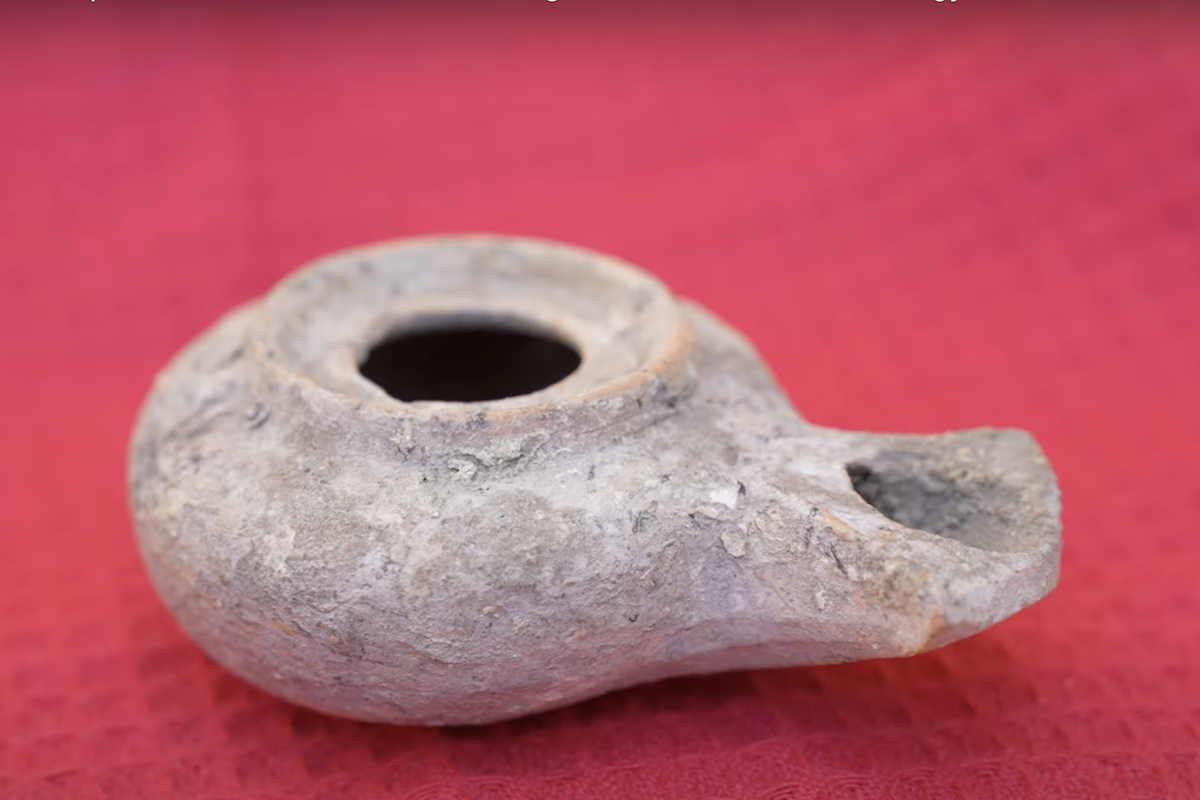Artifacts from Second Temple era found in Jerusalem, shed light on city’s final days before destruction in 70 A.D.
Stunning contrast observed between city layers pre-siege to time of siege and destruction

Remarkable artifacts were recently uncovered during the course of a new excavation in the drainage channel beneath Jerusalem’s main street from the Second Temple period. The artifacts included grape seeds, 2,000-year-old eggshells and intact ceramic lamps still bearing traces of soot.
The excavation, led by the Israel Antiquities Authority (IAA) and funded by the City of David, offers insight into Jerusalem’s urban evolution during the final decades before the Temple's destruction in 70 A.D. by the armies of Emperor Titus.

“Into the channel’s mouth were swept the detritus of life above Jerusalem's main street; where they remained preserved between the walls just as they were at the moment of the city’s destruction,” stated Dr. Ayala Zilberstein, the excavation director, on behalf of the IAA.
“Small finds tell us a big story, from Jerusalem’s heyday of prosperity and splendor when its streets bustled with life, until the city’s ebbing moments during the rebellion against the Romans, and its total abandonment following the Temple and city’s destruction,” she added.
As the excavators dug into the channel, they uncovered numerous items reflecting Jerusalem’s wealth and grandeur during the Second Temple period, a time when the city was vibrant with activity. In a meticulous excavation led by Nissim Mizrahi, the team discovered intact vessels, including ceramic perfume and oil vials, as well as a delicate glass vial that remained largely intact.
Dr. Yael Gorin-Rosen and Dr. Shulamit Terem's initial analysis of the pottery and glass vessels revealed an exceptionally rich and diverse collection, including some rare types.

Among the artifacts discovered was a broken ceramic flask, also dated to the 1st century A.D., and commonly called the "Pear-shaped bottle." This item was commonly used during Jesus' time for daily purposes and to hold oils and perfumes.
"Through this large variety of pots and dishes that accumulated in the drainage channel, we encounter nearly the complete tableware set of Jerusalem’s residents. In contrast to the limited set of vessels generally found when excavating a single household kitchen, the channel assemblage is drawn from many houses, and from different streets in town, thus presenting us with examples of almost all wares the city’s merchants had to offer," Zilberstein said.
In the upper layers of sediment, remains from the city’s destruction were uncovered, including whole and unbroken pottery lamps dated to the end of the Second Temple period, with soot preserved on their rims as evidence of the fires that once burned inside them.
These oil lamps dated to the Second Temple period, generally used during Jesus' time but also in 70 A.D., are called the "Herodian" or "Scraped Oil lamps." This style of lamp was widely used by Jews and pagans in the Holy Land during the 1st century A.D.
It was best suited for Jewish customs, as is was made of pottery and devoid of figurative designs to comply with the Old Testament's prohibition against depicting animals or humans.

Crafted on a potter's wheel, the lamp starts as a small bowl with a top opening for olive oil. A small rim prevents spills. After partially drying, the potter attaches the nozzle, where a linen wick would be lit, and scrapes the connection, giving the lamp its name.
A few years ago, just meters south of where these specific oil lamps were found, an intact Roman sword was discovered in the past, still within its leather scabbard, during an excavation led by the archaeologist Eli Shukron.
The archaeologists are now examining the eventuality that, similar to the sword, the oil lamps may have been held by rebels who sought refuge in the channel of the lower part of the city during the siege and destruction of Jerusalem by the Romans.
This channel, which served as Jerusalem’s primary subterranean artery, ran beneath various structures, including the bustling markets at the foot of the Temple Mount and along the entire length of the City of David, which is located in the southern part of the city.
The essential layers excavated in the channel are sampled using innovative techniques: The channel's layers of accumulated soil revealed a treasure trove of organic finds, prompting an array of laboratory tests to uncover remains not visible to the human eye.
During a preliminary analysis, led by Vitali Sterman and Dr. Yotam Asher from the IAA, a distinct contrast was observed between the layers from the city’s vibrant period and more recent layers dated to the time of the siege of the city and its destruction by Roman legions.

“The closer you get to the layers from the city’s later days – there is less and less evidence of human artifacts, and the picture begins to form of the demise of the city’s vitality,” Zilberstein noted.
Given the archaeological potential embedded in the channel’s accumulated strata, all excavated soil was carefully preserved and sent to the Sifting Project at Emek Zurim National Park.
Along with coins and colorful beads, the sifting project unexpectedly revealed food remnants that provided insights into the ancient Jewish diet. Researchers uncovered grape seeds, grain kernels, fish bones, and even eggshells. These discoveries shed light on the dietary habits of Jerusalem’s inhabitants during a period of vibrant city life.
Zilberstein commented: “Since most of these municipal channels were maintained and cleared regularly, to find layers of silt in the main drainage channel filling it to almost half its height, indicates a gradual neglect of city maintenance. And indeed, this very neglect and abandonment that we are now witness to here corresponds to the story of the process of Jerusalem’s destruction.”

IAA Director Eli Escusido said: “In these days, when the word ‘destruction’ takes on more relevance than usual, there is great value and it is important to look back into our past, to remember where we came from and what we went through, to connect with our history, and thus gain a broader view of our life here in Israel."
"As part of the new excavation now taking place near the Western Wall and the City of David, a great wealth of finds reveals to us a magnificent city full of life, which by its nature emphasizes the magnitude of the destruction and engenders our understanding of what was lost."

The All Israel News Staff is a team of journalists in Israel.
You might also like to read this:














